Table of contents
Deoxyribonucleic Acid, commonly called DNA, has proven to be one of the essential discoveries in human health. This double helix model holds the makeup of every human and is extremely important in tracing a person’s ancestry, possible cause of disease, and ethnicity. While there are many benefits of DNA, a striking area of importance is its usefulness for profiling or what is known as DNA fingerprinting.
What is DNA Fingerprinting?
Creating a DNA fingerprint involves a chemical test that analyzes the genetic makeup of a person or living thing and produces a pattern that is unique to that individual. It was created by Alec Jeffreys in the 1980s while he was at the University of Leicester in Leicester, UK. He discovered the technique after noticing that certain sequences of highly variable DNA, which do not contribute to genetic functions, are repeated within genes.
When the test is performed on a species such as plants or animals, it is known as DNA barcoding. The samples used for the test could be any tissue from the individual, and these include saliva, sweat, blood, hair follicles, skin flakes, and even clothes worn by the individual.
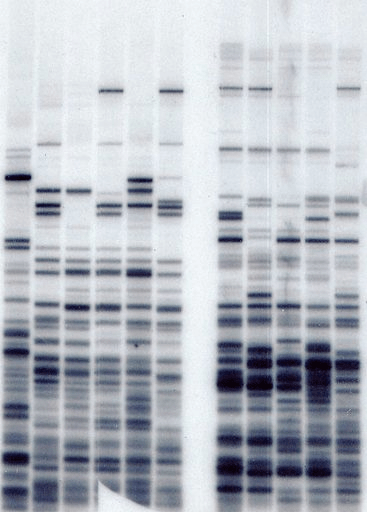
This test has been very useful in aiding forensic investigations and determining parents and close relatives. It is also used to find cures for hereditary conditions, establish immigration eligibility, and aid medical and genealogical research.
DNA fingerprinting is used to establish a link between two biological samples, such as blood evidence and the suspect of a crime. Traditionally, it has been used to solve dead-end criminal cases that would have been impossible to solve.
The Science behind DNA Fingerprinting
The genetic map of each individual shows that we all have our unique DNA. DNA exists in every cell of the human body and is a chain of chemical compounds that bind themselves together to create unchangeable blueprints throughout a lifetime. The compounds that make up DNA are four in number and are called bases. These compounds are known as base pairs when they pair up, and every human has an estimated three billion of these pairs. The cells make copies of these pairs and the complete set is known as a genome.
More than 99.9% of all humans’ genomes are alike. However, the minute difference in almost every person’s genome is responsible for our physical and mental uniqueness. Only identical twins share 100% of their DNA.
DNA fingerprinting analyzes the uniqueness of each person’s genome. The results can be used to match other samples to confirm or establish a particular situation.
DNA can be extracted from almost any part of the human body. However, some samples are more common due to the ease of extracting them. Samples are obtained from the following:
- Saliva
- Hair strands
- Blood
- Skin flakes
- Nails
- Urine
Performing DNA Fingerprinting
DNA fingerprinting is usually done in a lab, but it can also be performed at home by ordering a test kit from an approved and reputable genome testing company. To perform the test a cell sample is provided and this could be any of the extracts mentioned above. Most labs use blood as a common extract but are not limited to it.
Process 1: Restriction Fragment Length Polymorphism (RFLP)
First, human DNA is extracted from the biological sample. Next, the DNA is cut into smaller segments using restriction enzymes. When the DNA is cut, the pieces of DNA are separated on an agarose gel and labeled with radiolabeled probes. Some radioactive probes will bind to the DNA segments. Once unbound probes are washed away, the labeled fragments are analyzed under x-rays and a picture is made with x-ray film. While this process has been used for many years, it comes with limitations. Most notably, it takes a lot of DNA to perform and is often tedious, leading to it being more expensive.
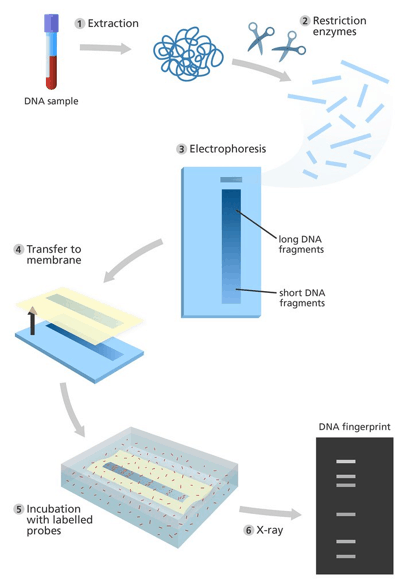
Process 2: Polymerase Chain Reaction (PCR) analysis
This method is more reliable than RFLP and is quicker and cheaper to perform.
After DNA is extracted from the sample, it is purified. Then, certain regions of the DNA are amplified using PCR. If longer segments of DNA are of interest, the amplified segments are usually separated in gel electrophoresis. Based on the size of DNA fragments, different DNA bands appear in a gel.
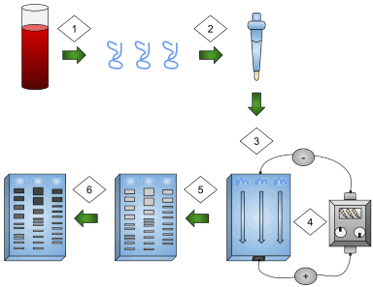
For smaller segments, such as short tandem repeats (STRS), an STR analysis technique called capillary electrophoresis is used to separate and identify these very small fragments.
Process 3: Real-time PCR
Real-time PCR is accurate, cheap, reliable, and quick. It also goes one step further by quantifying the amount of DNA in a sample, making it ideal for crime scene investigations. It even works on very small amounts of DNA.
Fluorescence-labeled probes are used to bind to certain sections of DNA. The instrument reads the fluorescence output to determine how much that sequence is being amplified during PCR. Taller fluorescent peaks indicate that there are more repeats of that labeled sequence, which allows scientists to calculate the number of repeats in a sample.
DNA sequencing and capillary gel electrophoresis can be used in combination with this method.
The more these segments that are tested, the more accurate the DNA profile will be. The strips will show a barcode-like pattern that can then be compared to another sample of DNA to find a match.
Purpose of DNA Fingerprinting
DNA profiling is mostly used for legal and official purposes. This could include criminal investigations and court hearings. It is, however, not limited to these areas as profiling can be done for personal reasons. There have been increasing cases of parentage testing to confirm the paternal and child status between individuals.
Benefits of DNA Fingerprinting
This technique has benefits that range from solving crimes to finding family members and proving paternity.
Forensic DNA Science: Criminal Investigations
DNA fingerprinting has received great acceptance in forensic science and crime investigations and has been widely used in these fields.
DNA extracts are much more difficult to mask compared to traditional fingerprints, and due to how easy it is for humans to shed DNA extracts, suspects can be identified with hair follicles, skin flakes, and saliva.
Recently, genetic database sites have been implemented by law enforcement. One of the most famous examples is GedMatch, which was used to arrest the Golden State Killer in 2018. Joseph James DeAngelo is accused of killing 12 people and raping 45 women across California between 1976 and 1986. Police checked the crime scene DNA from this time against the genealogy sites and tracked him through a distant relative whose DNA partially matched evidence related to the serial killer.
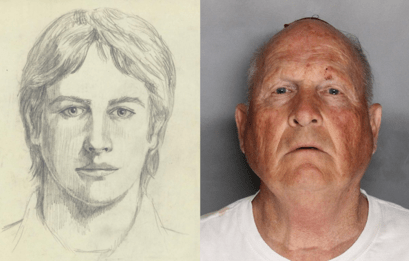
But there are limitations to this technology as well. Even if it is available, degraded DNA cannot be used for DNA fingerprinting. Additionally, the issue of genetic privacy and when criminal investigators can access this information is an ongoing ethical discussion.
If you’re interested in contributing your DNA to help solve crimes you may want to check out DNASolves.
Parentage testing and relatives tracking
DNA fingerprinting plays an important role in determining a parent of a child. It is mostly performed to confirm a child’s father.
DNA paternity testing is currently the most advanced and accurate test to determine parentage. The result of the test, called the probability percentage, is 0% when the supposed parent does not have any relationship with the child. While it typically stands at 99.99% if the opposite is the case.
DNA fingerprinting has also been effective in helping individuals trace their blood relations, such as siblings and immediate grandparents or grandkids.In most places of the United States, you can purchase at home DNA paternity tests although these kits are for peace of mind purposes only. They cannot be used in legal courts.
Medical research
DNA fingerprinting has received prominent attention in medical research and is believed by many medical professionals and experts to be one of the major routes into medical inventions and advancements. In the clinic, this test has been able to help health practitioners match the tissues of organ donors with patients who need transplants.
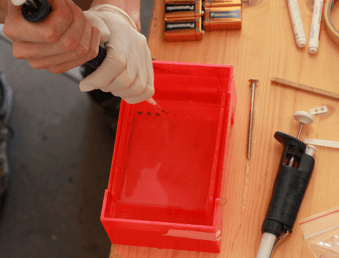
DNA profiling plays a major role in tracking down hereditary conditions in families. This has made it easier for health practitioners and genetic counselors to rule out the presence or risk of certain inherited diseases. Even in cases when a condition has been certified to be hereditary, the test makes it easier for health experts to recommend treatment for the conditions.
Identification
In cases where there is difficulty in identifying a body due to extreme damage, DNA fingerprinting can help identify an individual.
Indefinite storage
Once collected, an individual’s genetic profile created from DNA profiling can be stored in databases indefinitely. This profile can also be transformed into data points that can be used for research. This makes it easier for law agencies to identify suspects whose DNA has already been saved at a particular point in time.
Accuracy of DNA Fingerprinting
DNA fingerprinting is one of the most advanced technologies for identifying and linking individuals to each other or a particular situation. According to experts, DNA profiling is generally a very reliable method and gives extremely accurate genetic testing and forensic science results. However, most believe that it is still a developing science, and there has been true to this claim as human factors have been known to play a role in profiling.
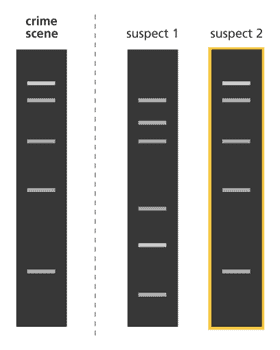
For forensic science, an error can occur in tests. After DNA is secured from a crime scene, extreme care has to be handled to prevent alteration and degradation. Improper storage can affect sample results and make findings unreliable. This can ultimately lead to improper convictions or exonerations. Even if the results are not affected, any improper handling of a DNA sample can lead to a change in the outcome of the case.
For the DNA paternity test, an individual can also read a false negative as the child’s parent when he is the parent. This happens when the individual has two distinct sets of genes, in a rare case known as Chimeras. In a situation like this, DNA profiling may give unreliable results.
FAQS
Is DNA Fingerprinting the same as fingerprinting?
No. DNA fingerprinting is a chemical test that uses DNA profiles to find a relationship with an individual(s), and the samples needed can range from blood to saliva, hair follicles, or sweat. Fingerprinting, on the other hand, makes use of fingerprints.
Is DNA Fingerprinting a reliable test for determining parentage?
Yes, it is. However, it may be unreliable in the rare case where one of the individuals tested has two different genes set.
Is there opposition to DNA evidence in criminal trials?
DNA evidence is considered an important piece of evidence in criminal trials. However, oppositions may question and seek clarity on how the test was done, whether there was improper handling, or if there are ethical considerations.
Nebula Genomics
At Nebula Genomics, we perform the most comprehensive 30X Whole Genome Sequencing to ensure that you can discover answers to all your genetic questions. This test sequences 100% of your DNA compared with just 0.2% offered by other companies.
Using the Nebula Research Library you can discover research on the most up to date genetic discoveries and compare the results with your own genome. Through this service you can unlock more personal genetic information than ever before.
Nebula Genomics is the most affordable way to sequence your entire genome. Interested in learning more about your ancestry? We also offer deep ancestry insights through our partnership with FamilyTreeDNA.
See what questions you can unlock by sequencing your DNA today!
Check out our blog for more educational articles, including this one on the differences between DNA and RNA!
